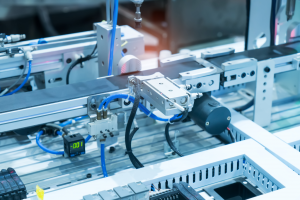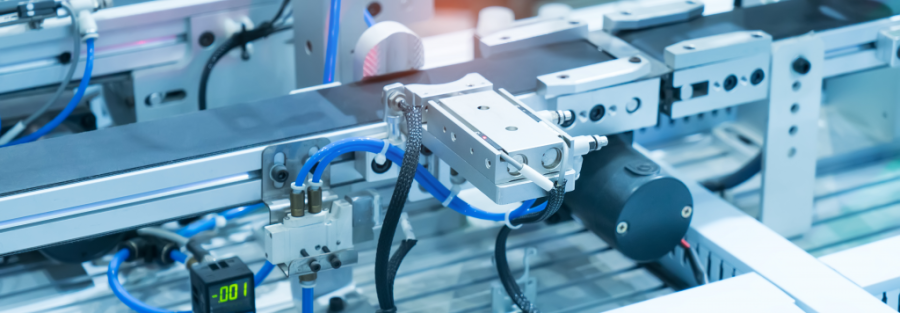AUTOMATION IN ACTION: 4 PRACTICAL USES FOR PNEUMATIC SYSTEMS
 For machinery, equipment, and tools to move, pneumatic systems need compressed air, a few basic parts, and a configuration of pipes or tubes. Pneumatic systems are becoming more and more engineers’ preferred choice for automation projects because of its simple, inexpensive, and eco-friendly power source. Actually, a wide range of industries EMPLOY pneumatic systems in a multitude of applications. In this article, we will examine the reasons behind the widespread use of pneumatic systems and examine 4 practical uses that highlight their versatility.
For machinery, equipment, and tools to move, pneumatic systems need compressed air, a few basic parts, and a configuration of pipes or tubes. Pneumatic systems are becoming more and more engineers’ preferred choice for automation projects because of its simple, inexpensive, and eco-friendly power source. Actually, a wide range of industries EMPLOY pneumatic systems in a multitude of applications. In this article, we will examine the reasons behind the widespread use of pneumatic systems and examine 4 practical uses that highlight their versatility.
Pneumatic systems depend on a number of parts to regulate and sustain airflow, which gives devices a steady supply of power. An air compressor inside the system draws in outside air and condenses it into a smaller volume. After that, the compressed air is sent via a filtering system and probably an air drier to get rid of moisture and impurities.
Once the compressed air reaches the system actuator, which powers connected devices like air-powered tools, robot end-of-arm tooling, or automated machinery, the treated air is then distributed through a series of valves that regulate, maintain, and direct the airflow through the distribution system of pipes and tubing. Pneumatic system motion profiles that are common include pushing, pulling, closing, lifting, and holding.
Using pneumatic systems in automation projects has a number of benefits, such as:
Reliability: Pneumatic systems are often quite dependable when in operation since they have simple components, are unaffected by temperature changes, and can withstand shock and vibration. Because air is easily accessible, pneumatic systems also offer a reliable supply of power.
Cost-Effectiveness: Pneumatic systems are inexpensive to build, have few moving parts, and require little upkeep. Furthermore, ambient air is available for free extraction from the environment. Pneumatic systems are among the least expensive power solutions because of these considerations.
Safety: Pneumatic systems minimize the risk of fire or explosion in situations where it may be problematic since they power equipment with air rather than sparks.
Flexibility: Pneumatics are an effective way to power various devices since one pneumatic system can precisely and consistently manage multiple components or applications. This eliminates the need for additional power sources. Furthermore, pneumatic systems may be easily customized to function in a variety of applications, ranging from small, delicate robots to heavy-duty equipment.
Cleanliness: Pneumatic systems offer a cleaner power source than hydraulic systems, which are infamous for fluid leaks. A pneumatic system may leak, but any air loss will just go back into the atmosphere. Additionally, treated air that satisfies strict criteria in sterile sectors like food and pharmaceutical processing may be produced using specialist oil-free or oil-less air compressors and the right filtering system.
Applications of Pneumatic Systems in Real Life
Given all the benefits that pneumatic systems provide, it’s hardly surprising that they’re employed in a broad range of automated applications, such as material handling, packing, conveying, and filling machinery, in sectors like general manufacturing, the automotive industry, and the food and beverage processing industry. Here are four real-world instances of pneumatic systems in use that demonstrate their adaptability.
Equipment for Processing Food
Equipment for chopping, cutting, slicing, and dicing is one use for pneumatic systems in the food industry. Pneumatic cylinders in these machines precisely control pressure and motion, minimizing food item damage. To chop, dice, or slice delicate things like cheese and baked products before packing, or fruits and vegetables in preparation for canning or freezing, consider using air-driven saws, knives, blades, and mandolins. Pneumatic-based cutting systems are sufficiently accurate to promote uniformity and are easily adaptable to process a wide range of sizes, thicknesses, and angles.
Robotic Arms
Pneumatically operated end of arm tooling (EOAT) is a technology that robotic arms use for a variety of industrial jobs. These operations include material handling, machine tending, assembly, and pick and place. Pneumatic systems are frequently employed to run robotic EOATs because of advancements in vacuum and pneumatics that enable more fluid movement and accurate speed and motion control.
Pneumatic systems, including vacuum EOAT, can be precise, repeatable, and provide fluid motion so they won’t damage delicate products. Additionally, because of their lightweight, simple design, pneumatic systems are easier, often less expensive, and require less maintenance than electronic systems. Finally, because pneumatics perform well in both hot and cold temperature extremes, they are perfect for use in applications where extreme temperature requirements must be met.
Making PET bottles
Pneumatics are being used in automated equipment as more and more plastic firms are switching to stretch blow molding methods for the creation of PET bottles. This is because pneumatics provide an affordable, adaptable, accurate, and repeatable motion profile. PET preforms are put on cores and sent through an oven in stretch blow molding machines to soften them. After that, high-pressure air is blasted on them to solidify the form and start the cooling process, and they are placed into molds that shape them into bottles. Pneumatic control valves are utilized during the expansion blowing process in this application, and pneumatics regulate the cores as they pass through the heating, stretching, and blowing processes.
Automotive Painting
Pneumatics is used in numerous processes in the automotive production industry, but painting and finishing is one of the most crucial ones. Bare automobiles are cleaned with dry, oil- and contaminant-free compressed air before painting to get rid of any contaminants that could have stuck during production. After washing, the paint is mixed and prepared using oil-free, clean, dry compressed air to guarantee uniform pigment dispersion. Lastly, the paint is sprayed onto the prepared automobile body using guns, robots, or paint sprayers, powered by compressed air. To assist produce a smooth and even manufacturing finish, the pneumatic system supplies high-quality, moisture-free compressed air during these processes.
If you are interested in Pneumatic Systems and automation or want to know more about how to improve production efficiency, please contact Robotnext today for advice and cost support. Details via hotline: 0909 914 837.
Other reference robot accessories:


